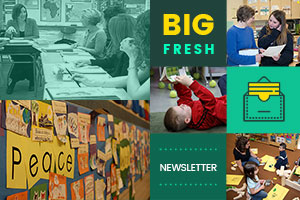Joy is not made to be a crumb.
Mary Oliver
Did you happen to catch the video of gymnast Katelyn Ohashi from UCLA performing a flawless and exuberant floor routine at a college meet? It was viewed by millions. Katelyn made the rounds of morning shows and newscasts, and the routine was even integrated into a Stephen Colbert comedy monologue.
What was inspiring wasn’t so much her skill (which was evident in spades) as much as it was Katelyn’s transcendent joy. Who knew gymnastics at that level could be so much fun? It is only when you dig a little deeper into Katelyn’s background that you realize reclaiming her love of gymnastics may be her greatest achievement.
Six years ago Katelyn was the top gymnast in the world, besting even Simone Biles on the world stage. But when you look at her routines from years ago, you don’t see any joy in them. You see a little girl, barely a teen, with fierce concentration and a frown on her face, head bowed after every error. You want to reach out and give that poor kid a hug.
Katelyn describes herself as broken during this period, and her body was literally coming apart from the stress of competition — her catalogue of injuries included a broken back and torn shoulders. “I was the best in the world, until I wasn’t,” she explains in a matter-of-fact monotone. It’s nearly impossible to reconcile that little girl with the proud, strong, and happy woman of that viral video.
The turning point for Katelyn came when she abandoned the top tier of competition. She decided instead to become a college gymnast—a step down that ensured she would never make the Olympic team. And that is where the world discovered her this winter. You can’t help but notice her teammates in the background in that video, clapping and bobbing along as she moves. It’s clear they know every second of her routine. Her success is their success. It’s delicious irony that she may have achieved more fame through that viral video than she ever might have on the Olympic stage.
Adam Grant writes, We make too many career choices based on ambition over aspiration. Ambition is what we want to achieve. Aspiration is who we want to become. As the calendar turns to March, it’s time for many teachers and literacy coaches to think about career moves. If you’re reading a literacy leadership newsletter right now, you’re probably already recognized as one of the best at what you do in your school or district. If you’re skilled and at the top of your game, there will always be pressure to keep moving “up” — to be ambitious and land on the next rung on the administrative ladder.
But who is it you aspire to be every day in schools? That is the question that matters. I am struck every year by how many of the Choice Literacy contributors move from coaching back to classroom teaching. It isn’t that they aren’t successful, it’s that they’ve learned where their joy lies. They find more fulfillment in building relationships over a year with children in classroom communities, and they have the confidence and strong sense of self to know it is the best move for them.
There’s nothing wrong in moving from teaching to coaching either, or from coaching to a high-level administrative level. Just be sure before you get on that new mat that you’ll have the team you need to support you, and you’re choosing aspiration over ambition.
Mary Oliver was right — joy should not be a crumb, a little leftover bit or afterthought. It’s the whole cake, a big ole piece of pie. It should fill you up and satisfy. The role you choose in schools after years of honing your skills is a treat you give yourself.
This week we look at how the concept of scaffolding works in literacy workshops. Enjoy!
Brenda Power
Founder, Choice Literacy

This week we’re featuring two all-time favorite articles from Choice Literacy that have helped scores of teachers understand how to scaffold learning.
“Gradual release” is at the heart of the concept of scaffolding. Clare Landrigan and Tammy Mulligan bring the concept to life.
How much is too much support while conferring? Terry Thompson explores the language of scaffolding and rescuing.
Lev Vygotsky was a Russian scholar who died tragically young almost 100 years ago. He defined the concept of scaffolding learning. Christine Sarikas gives background on the development of the concept and how it works in classrooms.
Coaches in any discipline could learn a lot from how Valorie Kondos Field, Katelyn Ohashi’s coach at UCLA, approaches her work. With no experience as a gymnast, Kondos Field brings a unique perspective and unorthodox methods to her mentoring.
We hope you’ll make our online course program part of your personal improvement plan this winter. Instructors include Ruth Ayres, Katherine Sokolowski, Dana Murphy and many others. Topics in the self-paced classes include student research projects, smarter reading conferences, and better coaching cycles. Members receive discounts of 20-40% on course fees, and nonmembers receive three-month trial memberships to the website.

New members-only content is added each week to the Choice Literacy website. If you’re not yet a member, click here to explore membership options.
Tara Barnett and Kate Mills show how to break down mentor texts into brief excerpts for step-by-step scaffolding of writers in the intermediate grades.
Melanie Meehan details how different paper options can be a powerful scaffold for students as they explore different writing genres. She includes many sample scaffolds to download for use in an opinion writing unit.
In this week’s video, Bitsy Parks confers with Aubrey early in the year, using books from whole-class lessons as a scaffold for understanding key text elements like title, author, and illustrations.
In an encore video, Beth Lawson helps a fourth grader visualize the plot of the mystery he is writing by using the scaffold of an image of a roller coaster.

Lead Literacy now has a new home as the Leaders Lounge at Choice Literacy. We’ll be posting the new content updates here in the Leaders Lounge section of the Big Fresh newsletter.
Ruth Ayres explains how to scaffold teachers as writers with continuous invitations and low-risk opportunities.
In a demonstration lesson, Tammy Mulligan scaffolds talk in a fifth-grade book club with the transcript of another student reading group. The video includes a planning session with the teacher and debrief.
New PD2Go: Helping students learn to help each other is one of the biggest challenges teachers face, but it’s the best way for students to scaffold each other’s learning. This new PD2Go workshop includes video from Katherine Sokolowski coaching two readers on how to give reading suggestions to each other, and an article by Tara Barnett and Kate Mills on how to assist students in selecting partners in more sophisticated ways.
If you are going to scaffold learning at any age, you have to become comfortable with waiting (and sometimes waiting and waiting) for response. Dana Murphy shares suggestions for both embracing and powering through those awkward silences during professional development sessions.
Jennifer Gonzalez gives examples of the difference between the language of control and the language of scaffolding for problem-solving in classrooms. This would be a provocative piece to discuss in a professional development session on scaffolding.
That’s all for this week!



